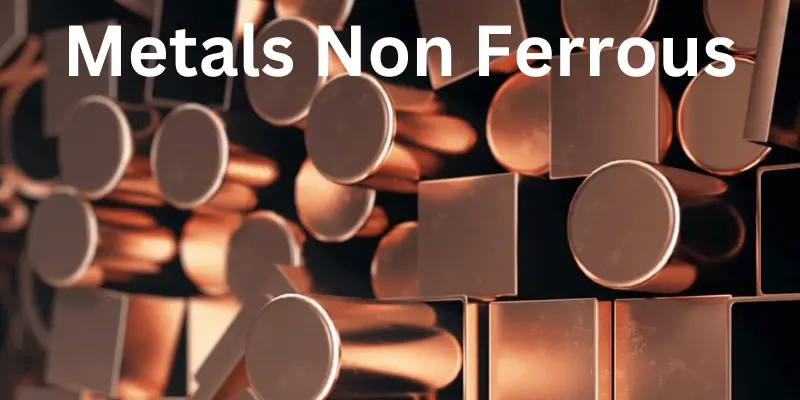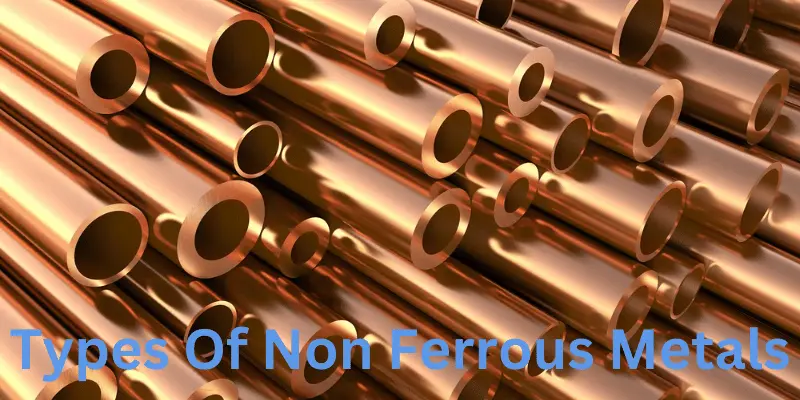What Is Non-Ferrous Metals | Types | Pros And Cons – Complete Guide
Updated: 09 Sep 2024
1105
Non-Ferrous metals are all around us, from the wires in our homes to the cans in our fridge. But did you know there’s a special group of metals called non-ferrous metals that play a huge role in our daily lives? Unlike iron and steel, these metals don’t rust and are often lighter and more flexible, making them incredibly useful. In this guide, we’ll break down what non-ferrous metals are, where you’ll find them, and why they’re so important in everything from electronics to construction. Let’s dive into the world of non-ferrous metals!

What Are Non Ferrous Metals
Non-ferrous metals that do not contain iron. This makes them different from metals like steel or iron, which are called ferrous metals. The big advantage of non ferrous metals is that they don’t rust and are often more lightweight. Because of this, they’re perfect for things like electrical wiring, building materials, and even everyday items like soda cans.
Aluminum, copper, zinc, and tin are examples of metals that are free from iron. These metals are used in many industries because they are strong, flexible, and resistant to rust.
Table of Contents
Why Are Non-Ferrous Metals Important?
Non ferrous metals play a crucial role in modern life. They are essential for various industries and applications due to their unique properties. Here’s why they’re so important:
1. Protection from Rust
- Non ferrous metals are less likely to rust or corrode, making them perfect for places exposed to moisture and chemicals.
- This resistance extends the lifespan of products and reduces maintenance costs.
2. Lightweight Properties
- Many metals without iron, such as aluminum and titanium, are much lighter compared, which is important in industries such as aerospace and automotive.
- Lowering weight in vehicles and aircraft improves fuel efficiency and performance.
3. Excellent Conductivity
- Non ferrous metals like copper and aluminum have outstanding electrical and thermal conductivity.
- This property makes them essential for electrical wiring, electronics, and heat exchangers.
4. Ability to be shaped and stretched
- Non-ferrous metals are easy to shape, can be turned into wires, or made into different products without cracking.
- This versatility allows for a wide range of applications in manufacturing and construction.
5. Recyclability
- Most non ferrous metals can be recycled without losing their properties, contributing to sustainability and reducing the environmental impact.
- Recycling non ferrous metals conserves natural resources and energy compared to extracting new materials.
6. Technological Advancements
- Non ferrous metals are essential in advanced technologies, including electronics, renewable energy (like solar panels), and medical devices.
- Their unique properties enable innovations that improve efficiency, safety, and performance in various fields.
The importance of non-ferrous metals cannot be overstated. Their unique properties, such as corrosion resistance, lightweight characteristics, and excellent conductivity, make them integral to modern technology and industry.
Different Kinds of Non Ferrous Metals
Non-ferrous metals are available in different types, each having its own special features and uses. Below are some of the most common kinds:

- Aluminum one of the most common types of non-ferrous metals. It is widely used because it is light in weight and easy to shape. Aluminum is also the main metal in many alloys.
- Copper is a metal that doesn’t contain iron. It is known for its great ability to conduct electricity, which is why it is commonly used in wiring, plumbing, and electronics. It’s also used in roofing and as part of heat exchange systems due to its ability to conduct heat.
- Zinc is commonly used for galvanizing steel, which helps prevent rusting. It’s also used in batteries, paints, and alloys like brass, offering durability and corrosion protection.
- Lead is heavy and malleable, often used in batteries, radiation shielding, and as part of roofing materials. However, its toxicity has led to more careful usage in modern applications.
- Nickel is resistant to corrosion and high temperatures, making it essential in the production of stainless steel and super alloys for use in jet engines, turbines, and other high-performance equipment.
- Titanium Known for its strength and lightness, titanium is used in aerospace, medical implants, and high-performance sports equipment. It’s highly resistant to corrosion, even in extreme environments.
- Gold and Silver: Gold in a non ferrous metal that is used in jewelry coinage.. These precious metals are not only valuable but also have excellent conductive properties. They are used in jewelry, electronics, and in certain industrial applications where conductivity and resistance to corrosion are key.
- Brass is made by combining copper and zinc, known for being strong, resistant to rust, and having a shiny golden look. It is commonly used in plumbing, musical instruments, and decorative objects.
- Bronze is a metal made mostly from copper and tin. It is strong and doesn’t rust easily. People have used it for hundreds of years in tools, statues, and machines. Even today, it is still commonly used in boat equipment and artwork.
| Metals | Tensile Strength | Resistance to Rust/ Corrosion | Electrical and Thermal Conductivity | Boiling Point | Melting Point | Common Application |
| Aluminum | 70-700 MPa | Good | Good Conductor | 2,470°C | 660°C | Aerospace, automotive, construction |
| Copper | 200-400 MPa | Moderate | Excellent Conductor | 2,562°C | 1,085°C | Electronic, energy, construction, tools |
| Zinc | 120-200 MPa | Moderate | Poor Conductor | 907°C | 420°C | Solar panels, handrails, car bodies |
| Lead | 12-17 MPa | Poor | Poor Conductor | 1,749°C | 327°C | Ammunition, battery, radiation shielding |
| Nickel | 240-780 MPa | Excellent | Good Conductor | 2,913°C | 1,455°C | Batteries, energy and power, electrical and electronics, chemicals |
| Titanium | 400-1100 MPa | Excellent | Poor Conductor | 3,287°C | 1,668°C | Automotive, aerospace, medical |
| Gold | 100-200 MPa | Excellent | Excellent Conductor | 2,856°C | 1,064°C | Jewelry, electronics, dentistry |
| Silver | 170-220 MPa | Good | High Conductor | 2,162°C | 962°C | Jewelry, electrical components, mirrors |
| Brass | 200-550 MPa | Good | Good Conductor | 1,740°C | 900 – 940°C | Plumbing, electrical, aircraft, musical instruments |
| Bronze | 350-700 MPa | Poor | Poor Conductor | 2,200°C | 950 – 1,000°C | Coins, instruments, statues, automobile |
Benefits and Drawbacks of Non-Ferrous Metals
Understanding the advantages & disadvantages of non ferrous metals is essential for making informed decisions in manufacturing and construction. Here’s a closer look at both sides:
Advantages
Non-ferrous metals provide special advantages such as resistance to rust, being lightweight, and having great ability to conduct electricity. These qualities make them essential in industries from aerospace to electronics
| Pros of Non Ferrous Metals |
|---|
|
Disadvantages
Despite their many benefits, non ferrous metals come with certain drawbacks, such as higher costs and lower strength compared to ferrous metals. Understanding these limitations is important for selecting the right material for specific applications.
| Cons of Non Ferrous Metals |
|---|
|
Non-ferrous metals have many benefits, including resistance to rust, being light in weight, and having great conductivity, which makes them essential for many uses. However, they also come with some disadvantages, including higher costs and lower strength in certain cases. Understanding both sides helps industries make informed decisions when choosing materials for their projects.
Common FAQs About Non-Ferrous Metals
Got questions about non ferrous metals? Here are some frequently asked questions to help you better understand their properties, uses, and benefits.
Can non-ferrous metals be recycled?
- Non-ferrous metals can be recycled easily. They can be melted and used again without losing their quality. Recycling these metals helps save natural resources and lessens harm to the environment.
Some common uses of non-ferrous metals?
Non-ferrous metals are applied in many different ways, such as:
- Aluminum: Used in packaging, transportation, and construction.
- Copper: Commonly found in electrical wiring and plumbing.
- Titanium: Used in aerospace, medical implants, and high-performance equipment.
Why do non-ferrous metals cost more than ferrous metals?
- Non-ferrous metals may be stronger costly due to factors such as the complexity of extraction, lower availability, and higher production costs. However, their unique properties often justify the price in many applications.
Is it possible to weld non-ferrous metals?
- Indeed, several non-ferrous metals can be joined through welding, but the process may require special techniques and equipment. For example, aluminum and titanium have different welding requirements compared to steel.
How are ferrous metals different from non-ferrous metals?
- The main difference is that ferrous metals have iron in them, while non-ferrous metals don’t. This affects how they behave; for example, ferrous metals can rust, but non-ferrous metals resist rust and corrosion better.
Are there any environmental concerns with non-ferrous metals?
- Yes, while non-ferrous metals are generally better for the environment due to their recyclability, the mining and processing of some metals can lead to environmental issues. It’s important to ensure that these processes are managed responsibly to minimize their impact.
Conclusion
Non-ferrous metals play a vital role in our modern world. With their unique properties—like corrosion resistance, lightweight characteristics, and excellent conductivity—they are essential in various industries, from aerospace to electronics.
Understanding these metals helps us appreciate their significance in everyday products and technological advancements. Whether you’re involved in manufacturing, construction, or simply curious about materials, non-ferrous metals are worth knowing about!
In conclusion, non-ferrous metals offer numerous advantages, but also have some limitations. Explore more about these metals and make informed decisions for your next project!
Bonus Points About Non-Ferrous Metals
- Diverse Applications: Non-ferrous metals are used in a variety of of products, from everyday things such as cans and cookware to advanced technologies such as smartphones and electric vehicles.
- Lightweight Alloys: Many non-ferrous metals can be combined to create lightweight alloys, which improve strength and durability while reducing weight. This is particularly beneficial in the fields of air and vehicle technology.
- Antimicrobial Properties: Certain non-ferrous metals, like copper, have natural antimicrobial properties, making them ideal for applications in healthcare settings, such as touch surfaces and medical equipment.
- Conductivity Innovations: Researchers are continually exploring new non-ferrous metals and alloys for their electrical and thermal conductivity properties, leading to advancements in energy efficiency and electronics.
- Economic Impact: Recycling non-ferrous metals helps save natural resources and also boosts local economies by providing jobs in recycling and manufacturing.
- Global Demand: As technology continues to advance, the demand for non-ferrous metals is expected to grow, particularly in renewable energy sectors, such as solar and wind power.
- Historical Significance: People have been using metals that don’t contain iron for many thousands of years, from ancient copper tools to modern aerospace applications, showcasing their enduring value in human development.
Please Write Your Comments